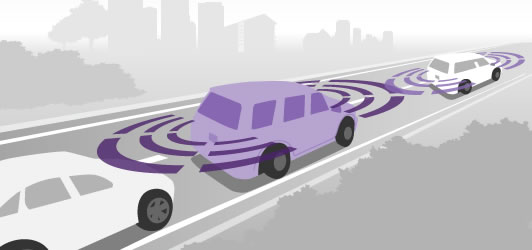Case Study: Intelligent Vehicles

In recent years, Ford has unveiled numerous safety and driver-assist technologies that rely on radars and cameras to warn the driver of an impending dangerous situation and even intervene if necessary. These technologies include, for example, Lane Keeping Alert, Collision Warning with Brake Support, Adaptive Cruise Control and other features discussed in our Accident Avoidance Technologies and Driver-Assist Technologies sections. At the same time, we have been undertaking research – both on our own and in partnership with others – to take these technologies to the next level.
This “next level” involves improving the performance of these systems such that they can be used in onboard vehicle-to-vehicle (V2V) and even vehicle-to-infrastructure (V2I) communications. In addition to the radar and cameras in use today, advanced Wi-Fi, cellular technologies (GSM/3G or 4G/LTE) and global positioning systems will provide the foundation to build an entirely new landscape of features for the purpose of safety, convenience and eco-mobility.
Ford is rapidly expanding its commitment to “intelligent vehicles” that can wirelessly talk to each other, warning each other of potential dangers to enhance safety and flag impending traffic congestion for more efficient driving. Such systems could potentially help in 81 percent of all police-reported vehicle-to-vehicle crashes involving unimpaired drivers, according to a National Highway Traffic Safety Administration (NHTSA) report. In 2011 we are doubling our investment in intelligent vehicles, forming a new 20-member task force of scientists and engineers to explore the technology’s broader possibilities and becoming the first automaker to build prototype vehicles for demonstrations across the U.S.
Ford’s vehicle communications technology will allow cars to talk wirelessly with one another using advanced Wi-Fi signals, or dedicated short-range communications, on a secured channel allocated by the Federal Communications Commission. The Wi-Fi-based radio system allows 360 degrees of detection and can “look” around corners for potentially dangerous situations, such as when a driver’s vision is obstructed.
Intelligent vehicles could warn drivers if there is a risk of collision when changing lanes, approaching a stationary or parked vehicle, or if another driver loses control. Drivers also could be alerted if their vehicle is on a path to collide with another vehicle at an intersection, when a vehicle ahead stops or slows suddenly, or when a traffic pattern changes on a busy highway. If vehicles approaching from opposite directions were communicating with each other, they could warn the drivers of oncoming vehicles, potentially avoiding head-on crashes.
By reducing crashes, intelligent vehicles could also ease traffic delays, which would save drivers both time and fuel costs. Congestion also could be avoided through a network of intelligent vehicles and infrastructure that processes traffic and road information. A traffic management center would send this information to intelligent vehicles, which could then suggest less-congested routes to drivers.
Ford has initiated a series of research and advanced projects to begin the rollout of intelligent vehicle technologies into our product lineup. Much of our work builds on the research conducted by the Crash Avoidance Metrics Partnership (CAMP), discussed in the Collaborative Efforts section.
In Europe, the “Safe Intelligent Mobility – Test Field Germany” (known as “simTD” for short) is investigating V2V and V2I communication under everyday conditions in a large-scale field operational test. In simTD, 400 vehicles are outfitted with V2V and V2I communications systems, and roadside units are set up in select locations around the test area. Both are also linked up to traffic control centers. During the test, participating drivers may, for example, receive information about a traffic jam or road accident, so they can choose an alternate route. One hundred drivers are actively participating and collecting data by completing specific driving tasks, while 300 drivers are passively taking part by driving where they would normally go. Ford is providing test vehicles for the project, as well as leading the development of the Electronic Emergency Brake Light system, which warns the driver of a heavily braking vehicle ahead.
The simTD project will run through 2012 around Frankfurt, Germany. It is a joint effort with other OEMs, suppliers, telecommunication providers and research institutes, as well as public authorities. It receives funding from the German government.
Ford is also contributing to the European harmonization and standardization of wireless communication systems and applications within the framework of the DRIVE C2X project, which is co-funded by the European Commission. DRIVE C2X is the acronym for “DRIVing implementation and Evaluation of C2X communication technology in Europe.” (C2X stands for “car-to-infrastructure,” and means the same as V2I.) This project kicked off in January 2011 and brings together more than 40 stakeholders, such as OEMs, suppliers, universities and public authorities from all over Europe. Within the framework of DRIVE C2X, field operational tests in a real-world environment will be conducted in seven test sites in Europe.
Both simTD and DRIVE C2X are also targeted to pave the way for full deployment of V2V and V2I systems in Europe and provide Ford with relevant data needed as a basis for the development of next-generation safety and efficiency features.
In the U.S., NHTSA will decide in 2013 whether to initiate a rulemaking process for V2V technologies that could require these systems in new vehicles starting in some future model year. As seen in the examples above, Ford’s goal is not to just wait for governmental action in this area, but to accelerate the vehicle connectivity landscape to be a leader in smart, safety and eco-friendly customer solutions.
Related Links
- External Websites:
- Overview
- Economy Data
- Environment Data
- Society Data
